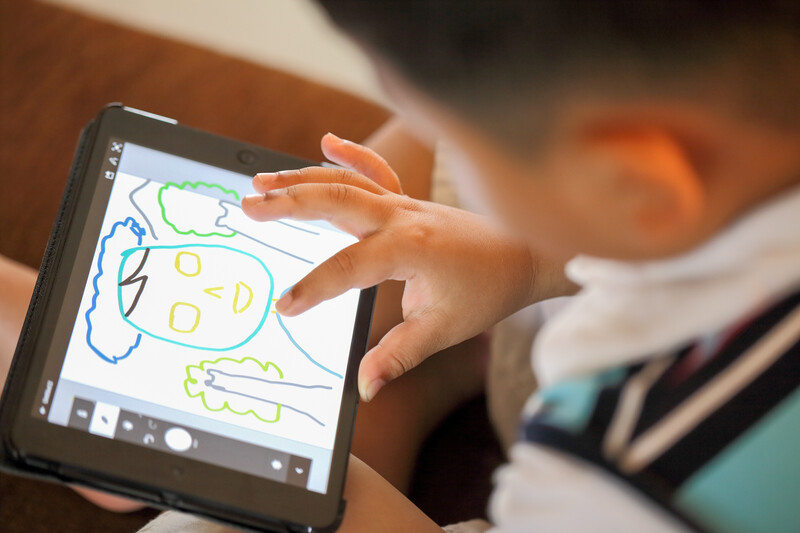If you were transported back to school, what kind of technology would most engage you? This is what we asked some leading technology educators.

Premium Resource
When I was in high school, I loved science. But some science topics are hard to teach because it's nearly impossible to represent them visually on a two-dimensional page in a book. For these topics, an interactive whiteboard would be powerful because it enables you to easily move, rotate, and manipulate objects on a big screen. For example, in learning about electron orbitals, being able to see where electrons are in the atom, how they move back and forth in chemical bonds, what makes a given element stable or unstable—and doing it in a visual way in real time—would be epic!
<ATTRIB>—Matt FederoffDirector of TechnologyVail School District, Arizona</ATTRIB>
As a student who loved to write and enjoyed the many possibilities of a blank page, wikis would appeal to me because of their boundless and organic nature. To have a teacher who would encourage me to create my own writer's profile, post my stories and essays, and then use the wiki as a space for collaboration and response. … Wow, that would have fed my soul as a young writer.
<ATTRIB>—Troy HicksAssistant ProfessorCentral Michigan UniversityMount Pleasant, Michigan</ATTRIB>
If I were a student today, I would want to see more web-based instruction. Today's high school students have never known a time before computers and cannot be expected to fully engage in a learning process without the interactive, multimedia format of the web.
Imagine attending a high school physics class where the entire curriculum was reformatted and put on the web. (For an example, see www.stmary.ws/highschool/physics/home/notes.) Students learning about electricity in class could go home and reexperience the day's lesson on their home computer or smartphone. For instance, they could watch a YouTube video by the Massachusetts Institute of Technology showing how a light bulb glows brighter when its wires are submerged in liquid nitrogen. They could play an interactive flash game that challenges them to achieve a target current by dragging and dropping the correct number of batteries and resistors in a parallel circuit. Always on, everywhere education!
<ATTRIB>—Anthony MangiacaprePhysics Teacher, St. Mary's High SchoolManhasset, New York</ATTRIB>
If I were a student, I would most value tools that encourage me to create in new ways, build connections with others who are passionate about things I'm interested in, and be part of a "we" instead of an "I." These tools enable us to create stories using various modalities, including pictures, drawings, videos, and sound effects. One such tool is StoryKit, a mobile application that provides the flexibility to create anywhere. For example, students could use StoryKit to work with a grandparent to develop an interactive family history or to create a journalistic report during a field trip.
<ATTRIB>—Erin ReillyResearch Director of New Media LiteraciesUSC Annenberg Schoolfor Communications and JournalismLos Angeles, California</ATTRIB>
Cell phones are a way of life for teenagers. Students text instead of calling, text instead of e-mailing, and often text instead of talking to friends across a room. These devices have tremendous potential in the classroom. They are meaningful, authentic, and allow students to use a tool they are comfortable with. It's so easy to harness the power of this communication method in the classroom.
<ATTRIB>—Ryan ImbrialePrincipal, Patapsco High SchoolBaltimore County Public Schools,Maryland</ATTRIB>
Video chat technology, such as Skype, would most engage me as a student. Teachers can easily use Skype to bring experts into the classroom, take virtual field trips, or collaborate with other schools in real time. When studying the Holocaust, a teacher could Skype a survivor or historian so students could ask their own questions. This makes the learning experience much more authentic and meaningful.
<ATTRIB>—Eric SheningerPrincipal, New Milford High SchoolNew Milford, New Jersey</ATTRIB>
A digital projector is a powerful tool to engage students, but only if it's used well, in a way that brings the world into the confining four walls of the classroom. YouTube creators, Flickr photographers, and Vimeo videographers are providing rich curriculum resources for our teachers. They take students on tours of foreign cities. They let them witness live and historic events. When a picture is worth a thousand words, video is worth many times that, and a digital projector used well is invaluable in our mandate to challenge and engage.
<ATTRIB>—Dan MeyerHigh School Math Teacher, 2004–2009Doctoral Student, Stanford UniversityPalo Alto, California</ATTRIB>
My teachers' ability to connect me with content and information beyond the classroom would excite me the most. Give me content through my cell phone, my iPod, YouTube, and Twitter. Keep the conversation alive beyond just the 45 minutes a day we have in class. Let me use tools to create videos and audio files that demonstrate that I understand the material. I want my class to be active, not just lecture.
<ATTRIB>—Eric LanghorstTeacher, South Valley Junior High SchoolLiberty, Missouri</ATTRIB>



